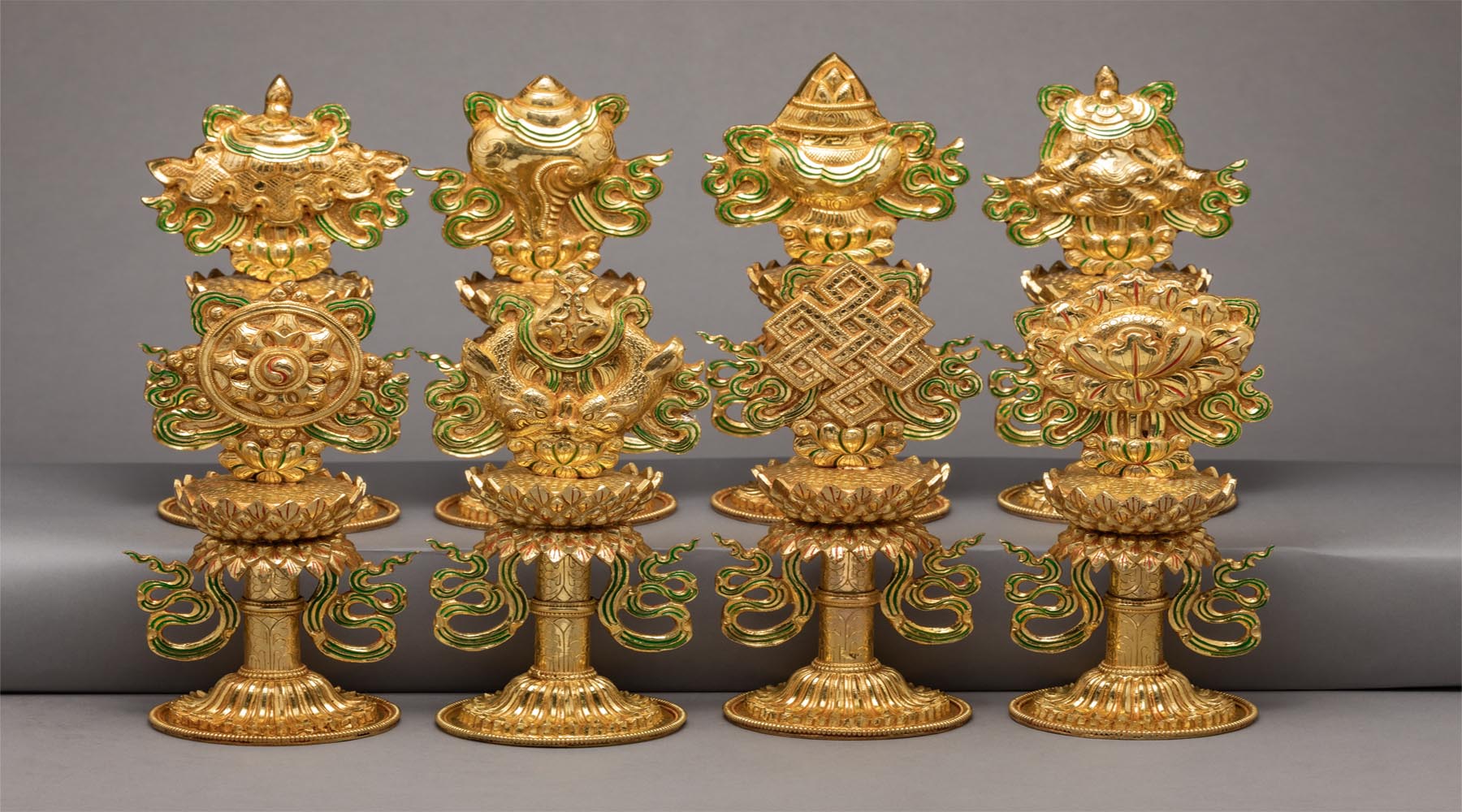The Five Buddhas Symbol
A double row of pendants has the colors blue and green on the upper row, and yellow and red on the lower row. They represent the colors of the four directions, or the Five Buddhas. Below the pendants is a red or orange silk skirt, which billows outwards as if lifted on a breeze.
Underneath the skirt is a long hanging silk scarf. It loops at its center and twists upwards at its extremities. A garland of jewels hangs behind the central loop of the scarf. The long axle-pole is usually painted in the red of fragrant sandalwood. It forms from a precious mineral, such as red coral or lapis lazuli.
The White-Canopied Parasol
The white-canopied parasol is usually held above the head of the Buddha by a beautiful god or goddess. The white canopy symbolizes his spiritual sovereignty. The peacock feathers are his secular power as chakravartin. The white canopy indicates a four-sided or square parasol. A flaming three-faceted jewel forms the pinnacle, with an ornate flowing apron below. The parasol of the Buddha has peacock feather and brocade valances.
It hangs four-color brocade pendants and double scarfs entwined in the four directions. There are hanging jewel garlands, and a pair of jewel chains with white yak tail whisks at their ends. The peacock-feather parasol floats above the head of the goddess Palden Lhamo. The secular nature of the peacock feathers illustrates her power over all realms. The eyes symbolize wisdom, and the many golden strands, method.
They represent Palden Lhamo performing activities for the benefit of all beings. On traditional white parasols, the finial has an auspicious bundle of peacock feathers. Two hanging silk pendants loop onto the golden Makara-tail crest-bar. An eight-faceted flaming jewel forms the finial. In iconography, the parasol and victory banner may have a similar representational form. Both are invariably depicted with white canopies.
The Victory Banner in Tibetan Buddhism
In Tibetan Buddhism, the victory banner, also an auspicious symbol, symbolizes eleven methods for overcoming some defilements. They are, the development of knowledge, wisdom, compassion, meditation, and ethical vows. Also, taking refuge in the Buddha, abandoning false views; generating spiritual aspiration. And the unity of the three samadhis of emptiness, formlessness, and the lack of desire.
Within the Tibetan Buddhist tradition, protective deities carry the victory banner. There are eleven specific forms of the victory banner that they carry. The three colors of the pendants are often red, white, and green or blue. They correspond to the elements of fire, water, air, or space. In Tibet, tall flagstaffs are at sacred sites near temples and monasteries.
Printed prayer flags are sewn within the square sections. Often a strip of white cotton printed with prayers extends along the length of the flagstaff. The poles are usually capped with a small circular dial and a flaming sword. They symbolize penetrative wisdom as Manjushri's emblem. A small parasol or victory banner, a jewel, trident, yak tail, or wool tuft, may also serve as a finial.
Flags and Banners in the Tibetan Tradition
The sword, spearhead, or trident emblem originate from the spear flag or trident-flag. The Tibetan national flag bears a small victory banner as the crowning emblem. Certain banners and flags have a specific association with various protective deities. They venerated as religious treasures in the temples which enshrine them. The three-valance flag is has a jewel and yak tail. The seven-valance flag has a small parasol. Hanging banners occur in many different forms within the Tibetan tradition.
Their many variations decorate walls, pillars, and beams. And as ceiling hangings in temples or monastic assembly halls. They are often named after their predominant color. They have five-color sequence of yellow, red, green, white, and blue. They represent the Five Buddha wisdom. One such continuous frieze has many layers of alternating five-color silk valances. They are in a sequence to create a zigzag pattern (Tib, bkra shis bkras ring).




